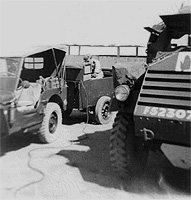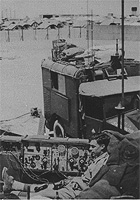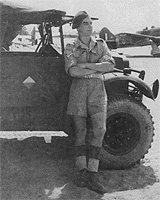
RAF Fayid October 1948Operating wireless set Canadian 52 Jeep & Trailer Station

2 ASSU Control Station. White Scout Care (foreground) & Morris Wireless Truck (known as Djinn Palace)

Me, with my truck
2 AIR SUPPORT SIGNALS UNIT - 1946-49
As Remembered By Gerald Reeve
THE Blanco can clattered its way along the deserted platform at Huntingdon North railway station. It was mid afternoon on the 19th November 1946. Much later that day the letter that had been tied to the tin was delivered to my father’s workshop by the LNER porter. My father interrupted his work, he was providing a wooden overcoat for a local departed, to learn that I had chosen a rapid delivery method to let him know I was on my way to the Middle East.
The troop train had left Thirsk in Yorkshire at 13:15 hrs taking Royal Signals Draft RMZYA on a non-stop journey to Dover. How it coped with the lines around and through London was a mystery to me and also to a group of squaddies from the Smoke. They kept us informed of our location and some were hoping for a brief home visit but we carried on non-stop to Dover. A midnight meal and we slept that night in Dover Castle.
Next morning an uncomfortable ferry crossing to a very battered Calais took one and half hours. We were able to walk around the town that day and view the Town Hall and the statue of the Burghers of Calais. In the Transit Camp I saw my first communal toilet – all sit round in a circle while an ancient French lady sweeps up around you! At 20:00 the next evening we boarded a train and travelled the MEDLOC route to Southern France. Through the night and at times very slowly because of the war damaged track. At dawn the next morning we stopped for a trackside wash and breakfast at Beaune. The train paused for a few moments at Lyons, Avignon and Marseilles then finally about 21:30arrived at Toulon. A 10 mile lorry journey took us to Medioc camp four miles from Hyenes. At Toulon, six days later, we boarded HM Troopship Empire Battleaxe, five days on the Med and we arrived at Port Said at 08:00 and then to 156 Transit Camp.
Three days at 156 and my first visit to the Canal Zone ended by crossing the harbour on a Z-craft and then by train to Almaza Camp Cairo. I was able to ‘walk out’ in Cairo (as my daily leave pass quaintly put it), using what was reputed to be the fastest tramway in the world. The Cairo Electric Railways & Heliopolis Oases Cy. Several of these ‘walks’ involved visiting one of our number who succumbed to an ailment and was in the Military Hospital. I also had a session or two at the Heliopolis roller skating rink.
A group of us had an educational experience near Shepheard’s Hotel. We were surrounded by several flower-selling girls pushing bouquets into our faces. Fortunately a passing English gent with an upmarket voice called out “Watch your pockets chaps”. The battle-dress top pocket buttons of several of us had been undone but we lost nothing. A lesson learned that stood me in good stead 22 months later when a Canal Zone pick-pocket got his hands briefly on my Conway Stewart fountain pen, pressure on his upper arm and I got it back.
Draft RMZYA remained at Almaza during December, its numbers continually being reduced by postings throughout the Middle East. Those waiting their postings were kept busy with guard duties, security piquet, early morning milk collection at 03:15, spud bashing, cookhouse servery, etc. We also guarded sick detention wallahs at 63 General Hospital. Christmas Eve I was in the cookhouse awaiting an incoming draft. Gave up at 01:30 and went to bed. Draft arrived at 04:30 when I served food until 05:30 then back to bed. The Sgts woke us with tea at 07:00. Served breakfast then back to bed until the WOs and Officers served Christmas Dinner. All this festive fun came to an end after Boxing Day and I was in a party posted to Palestine.
The train left from Cairo Station at 18:00 for my second visit to the Canal Zone – a meal at Kantara – and later a night time journey across the Sinai. An early manifestation of the Welsby effect followed (see Nov 2006 issue Canal Zoners). Sgt Major Hipperson paraded the new arrivals outside the unit office at Sarafand and ordered “Line up in alphabetical order”. Driver Webb groaned and said in a loud voice “Last again as always” from the dark interior of the office a quieter call came – “Send ‘em in in reverse order please, Sgt Major”. In went Webby first, at last, to be greeted with “Good Day Driver Webb, my name is Lieut Wright”
Having joined 2 Air Support Signals Unit the next 16 months were spent perfecting my morse code skills on radio links to the Iraq oil pipeline at H3 and H4, also with 6th Airborne on Mount Carmel at Haifa. 1 Div at Sarafand, the Lancers on the Dead Sea salt run and the RAF with their Spitfires at Ein Shemer.
During this time I was granted 14 days leave (LIAP) and travelled from Haifa to Famagusta on the good ship ‘Tripolitania’. Then by lorry to Pine Trees Camp in the Troodos mountains (11 days board cost 28 shillings) We climbed Mt Olympus, spent a day or two in Nicosia, went swimming at Limasol and all too soon back to Palestine.
The unit HQ moved from Sarafand to Mount Scopus just outside Jerusalem and we were billeted in the Augusta Victoria Hospice, a former Military Hospital and Army HQ. It was built by Kaiser Wilhelm II of Germany in 1898 as a hospice for pilgrims and named after his wife. A feature of life for us at this time was a requirement to share the bed with a Lee Enfield and 50 rounds of 303.
With the ending of the Mandate and the British evacuation from Palestine, I left Jerusalem in a lorry convoy for my third journey to the Zone. Two days were spent at Rafah having an engine replaced by REME. Then across the Sinai once more. Crossing the Canal at El Firdan via the military pontoon bridge operated by German POWs we arrived at El Ballah. A few days there during which I managed a swim across the Canal but soon on the move again and a longer stay at RAF Fayid. My third visit ended with a posting to RAF Khartoum. Tea was served as the Avro York followed the Nile south to the Sudan. While at RAF Khartoum we had a somewhat mysterious visit by a couple of REME sergeants who were from the War Office. They asked to see our vehicles – I had three on my charge – a White Scout Car at Khartoum, a Jeep and trailer which I had never seen and was last reported at Mogadishu. Out visitors rapidly lost interest and left. It all remained a mystery until 58 years later an article in the Canal Zoners Nov. 2006 issued explained all. Thank you Ken Welsby and “Being W Proved Lucky” – it was the Army version of the MOT.
During the hot nights we took our beds onto the flat roof of the billet where it was much cooler, occasionally to beat a hasty retreat when warned by the Control Tower of the imminent arrival of a sand storm. So down below we went to close shutters and doors. Sand storms were one of the hazards of attending the local open air cinemas, the screen was obliterated and the assemble company changed colour to a uniform dark brown. But the open air evening Café life of Khartoum was a delight surrounded by the many large Greek families enjoying the cooler evening air.
We took part in a few exercises out in the desert watching the
Hawker Tempests of 39 sqdn blast the desert rocks with 20mm cannon and getting
a perforated radiator for their trouble! A pleasant time at Khartoum during
which I was paid by the Sudan Defence Force, fed by the RAF and the Scout car
was serviced and repaired by the Lancers. No guards, no parades and Cpl Evans
RAF was always ready to take over my wire-less link duties so I was able to
get into the town. On several occasions I was able to do a Tour de Khartoum
on a RAF service issue upright bicycle. But demob was looming and five months
later I was one of seven passengers, six crew, several gas cylinders and various
boxes and crates in a freight carrying Dakota that landed first at Wadi Haifa
and then Fayid and for the fourth time I landed in the Zone.
|
|
2 ASSU Control Station. White Scout Care (foreground) & Morris Wireless Truck (known as Djinn Palace) |
Me, with my truck |
Operators Wireless & Line Group 1946 |
|
|
|
|